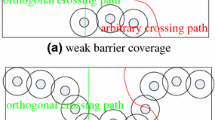Abstract
This paper proposes an algorithm, called the Optimized Barrier Coverage Algorithm (OBCA), to optimize the quality of the barrier coverage formed by a wireless sensor network (WSN). OBCA aims at optimizing the barrier coverage quality in terms of the detection degree, the detection quality, and the transmission quality (i.e., the expected transmission time). This paper also proposes a model to formulate the minimum detection probability between two WSN sensors with different sensing ranges. With the model, OBCA can be applied to heterogeneous WSNs whose sensors have various sensing ranges. OBCA’s optimization is proved, and its time complexity is analyzed. The performance of OBCA is simulated and compared with those of two related algorithms.














Similar content being viewed by others
References
Ball MG, Qela B and Wesolkowski S (2016) A review of the use of computational Intelligence in the design of military surveillance networks. Recent Advances in Computational Intelligence in Defense and Security, Springer, pp 663–693
Suri N, Tortonesi M, Michaelis J, Budulas P, Benincasa G, Russell S and Winkler R (2016) Analyzing the applicability of Internet of Things to the battlefield environment. In: Proc. of IEEE International Conference on Military Communications and Information Systems (ICMCIS), pp 1–8
Cavalcante E, Pereira J, Alves MP, Maia P, Moura R, Batista T, Pires PF (2016) On the interplay of internet of things and cloud computing: a systematic mapping study. Comput Commun 89–90(1):17–33
Botta A, de Donato W, Persico V, Pescapé A (2016) Integration of cloud computing and internet of things: a survey. Futur Gener Comput Syst 56:684–700
Rawat P, Singh KD, Chaouchi H, Bonnin JM (2014) Wireless sensor networks: a survey on recent developments and potential synergies. J Supercomput 68(1):1–48
Oppermann FJ, Boano CA, Römer K (2014) A decade of wireless sensing applications: survey and taxonomy. Springer, The Art of Wireless Sensor Networks, pp 11–50
Kumar S, Lai T-H and Arora A (2005) Barrier coverage with wireless sensors. In: Proc. of the 11th ACM annual international conference on Mobile computing and networking (MobiCom05), pp. 284–298
Yang G and Qiao D (2009) Barrier information coverage with wireless sensors. In: Proc. of IEEE INFOCOM
Chen A, Kumar S and Lai TH (2007) Designing localized algorithms for barrier coverage. In: Proc. of ACM Mobicom07, pp. 63–74
Chen A, Kumar S and Lai TH (2010) Local barrier coverage in wireless sensor networks. IEEE Transactions on Mobile Computing (TMC) 9(4);491–504
Saipulla A, Westphal C, Liu B and Wang J (2009) Barrier coverage of line-based deployed wireless sensor networks. In: Proc. of IEEE INFOCOM
He S, Gong X, Zhang J, Chen J and Sun Y (2013) Barrier coverage in wireless sensor networks: from lined-based to curve-based deployment. In: Proc. of IEEE INFOCOM
Saipulla A, Liu B and Wang J (2010) Finding and mending barrier gaps in wireless sensor networks, in Proc. of IEEE Globecom
Saipulla A, Liu B, Xing G, Fu X, and Wang J (2010) Barrier coverage with sensors of limited mobility. In: Proc. of ACM MobiHoc, pp. 201–210
Chen J, Wang B, Liu W, Yang LT and Deng X (2014) Rotating directional sensors to mend barrier gaps in a line-based deployed directional sensor network, IEEE Systems Journal. PP(99):1–12
Tao D, Tang S, Zhang H, Mao X, Li X, Ma H (2013) Strong barrier coverage detection and mending algorithm for directional sensor networks ad hoc sensor. Wirel Netw 18(1–2):17
Deng X, Wang B, Wang C, Liu W (2014) Barrier coverage in wireless sensor networks with adjustable sensing ranges. Int J Ad Hoc Ubiquit Comput 15(1–3):121–132
Kumar S, Lai TH, Posner ME, Sinha P (2010) Maximizing the lifetime of a barrier of wireless sensors. IEEE Trans Mob Comput 9(8)
Luo H, Du H, Kim D, Ye Q, Zhu R and Jia J (2014) Imperfection Better Than Perfection: Beyond Optimal Lifetime Barrier Coverage in Wireless Sensor Networks. In: Proc. of 10th IEEE International Conference on Mobile Ad-hoc and Sensor Networks (MSN 2014)
DeWitt J and Shi H (2014) Maximizing lifetime for k-barrier coverage in energy harvesting wireless sensor networks. In Proc. of 2014 Globecom
Balister P, Bollobas B, Sarkar A and Kumar S (2007) Reliable density estimates for coverage and connectivity in thin strips of finite length. In: Proc. of ACM Mobicom, pp 75–86
Lai YL, Jiang JR (2015) Optimizing sink-connected barrier coverage in wireless sensor networks. Int J Ad Hoc Ubiquit Comput 20(1):39–48
Cormen TH, Leiserson CE, Rivest RL and Stein C (2001) Introduction to algorithms. MIT Press
Elfes A (1991) Occupancy grids: A stochastic spatial representation for active robot perception. In: Proc. of the 6th Annual Conference on Uncertainty in Artificial Intelligence (UAI-90), pp 60–70
Draves R, Padhye J and Zill B (2004) Routing in multi-radio, multi-hop wireless mesh networks. In: Prof. of ACM MobiCom
Orlin JB, Ahuja RK (1992) New scaling algorithms for assignment and minimum cycle mean problems. Math Program 54(1–3):41–56
Texas Instruments (2016) CC2420 datasheet, URL: www.ti.com/lit/ds/symlink/cc2420.pdf, last accessed in August 2016.
Google, An introduction to or-tools, Google's software suite for combinatorial optimization, URL: https://developers.google.com/optimization/, last accessed in December 2016.
Panasonic. PIR motion sensors (Passive Infrared or Pyroelectric) from Panasonic for optimal usability and reliability. URL: http://www3.panasonic.biz/ac/cdn/e/control/sensor/human/catalog/bltn_eng_papirs.pdf, last accessed in December 2016.
Acknowledgements
This work was supported in part by the Ministry of Science and Technology (MOST), Taiwan, under Grant Nos. 104-2221-E-008-017-, 105-2221-E-008-078- and 105-2218-E-008-008-.
Author information
Authors and Affiliations
Corresponding author
Rights and permissions
About this article
Cite this article
Lai, YL., Jiang, JR. Optimizing Detection Quality and Transmission Quality of Barrier Coverage in Heterogeneous Wireless Sensor Networks. Mobile Netw Appl 22, 959–969 (2017). https://doi.org/10.1007/s11036-017-0858-1
Published:
Issue Date:
DOI: https://doi.org/10.1007/s11036-017-0858-1




